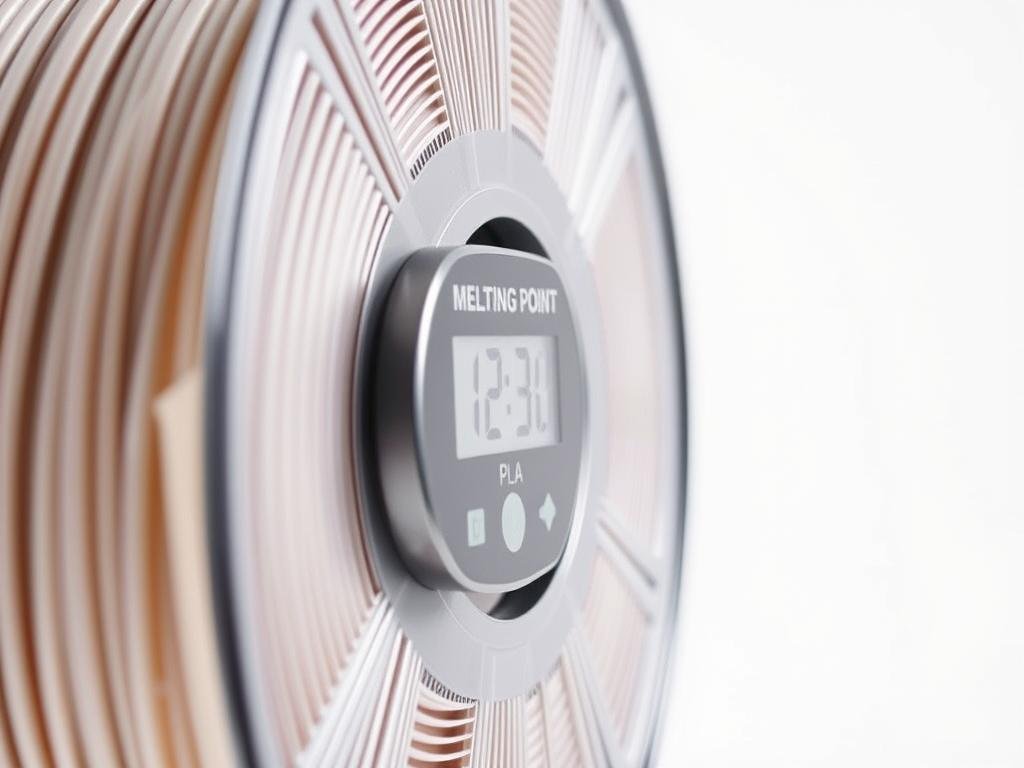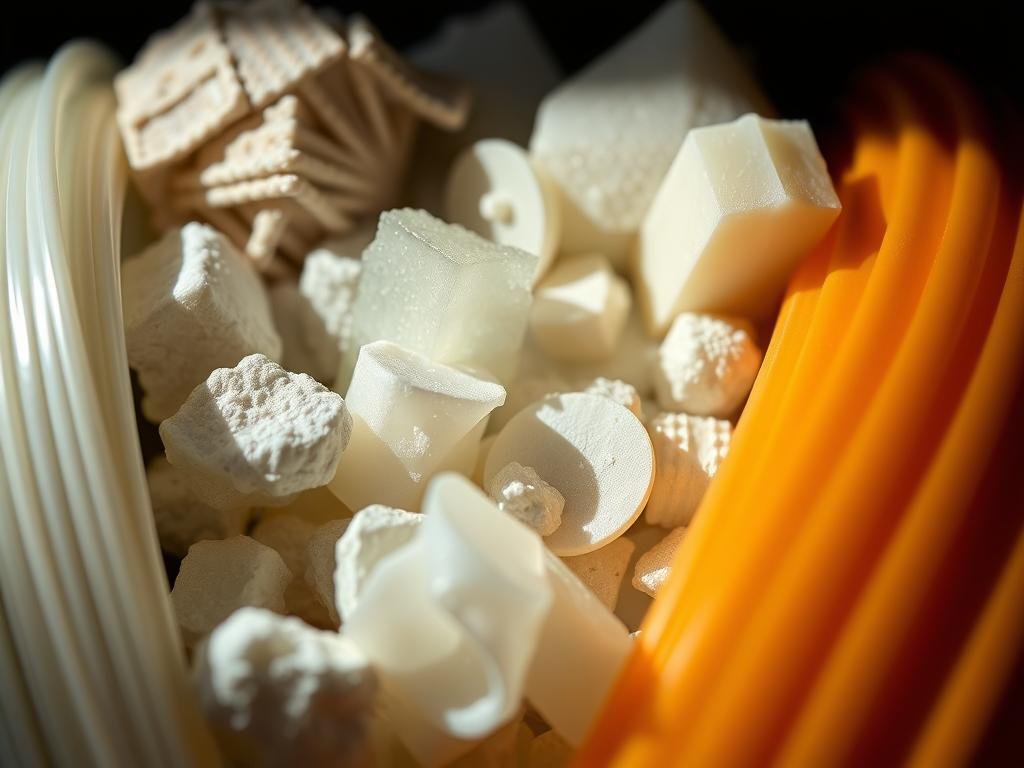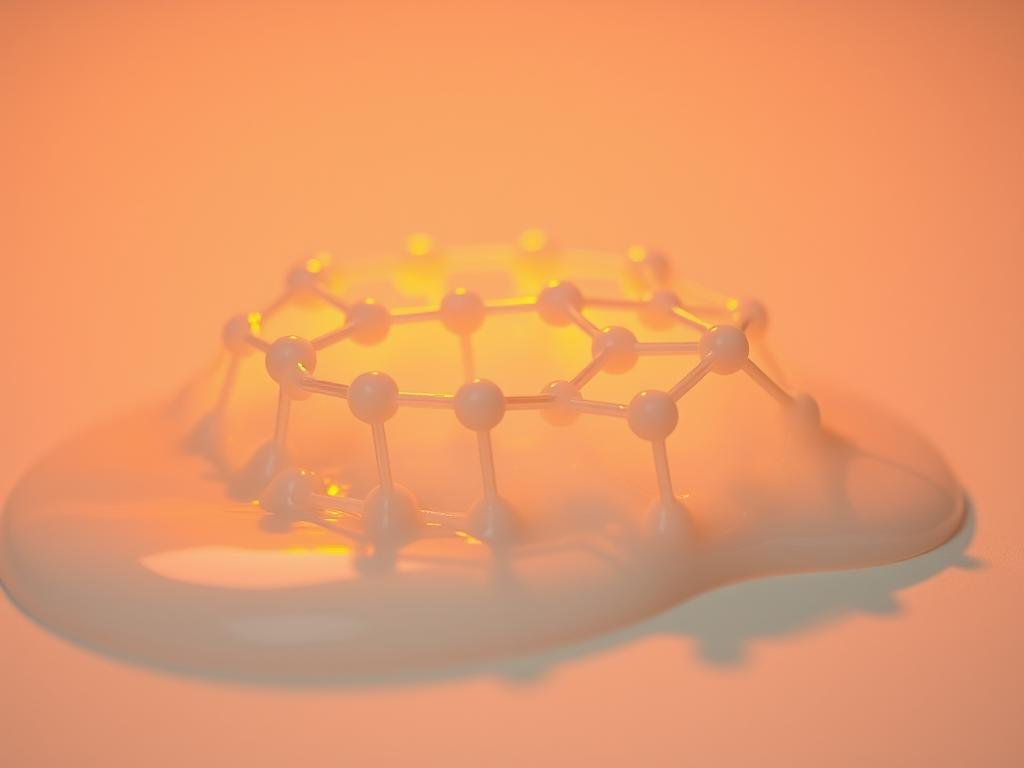Surprising fact: many hobbyists set nozzle temps 20–40°C above the softening range, yet most brands list nozzle recommendations that land near 180–220°C for safe extrusion and bond strength.
This short guide defines that key temperature range in plain terms and contrasts it with the glass transition around 60–65°C. Clear definitions help you avoid weak layers, stringing, and other print flaws.
Expect a crystalline melt window roughly between 150 and 180°C, while actual nozzle settings sit higher to ensure smooth flow. Additives and colorants change this window and affect surface finish.
Rapidaccu brings over 15 years of CNC and manufacturing experience, so we stress practical control: bed heat, fan timing, and open-air practices matter for reliable results and prototype fidelity.
For a deeper, data-driven look at the empirical ranges and testing methods, see this detailed discussion on PLA melting point.
Understanding PLA: Polylactic Acid Basics for Makers and Engineers
Polylactic acid is produced from fermented plant starch such as corn or sugarcane and forms a thermoplastic polyester used across desktop printing and prototyping.
This material blends renewable chemistry with practical properties that make it popular in FDM workflows. It offers low warpage, good layer adhesion, and clean extrusion that helps both new users and seasoned engineers.
Composition and common properties
Polylactic acid derives from lactic acid monomers and sits among biodegradable polymers. As a plastic it prints at modest temperatures and shows low thermal expansion.
- Good stiffness and low shrinkage for accurate parts.
- Predictable flow and surface finish with standard filaments.
- Variants, colorants, and processing alter strength and sheen.
Glass transition versus melting
Glass transition occurs near 60–65°C; the polymer softens and can deform in warm environments like hot cars. Melting ranges vary by crystallinity from roughly 130–180°C, which defines when crystalline regions lose structure.
| Property | Tg (°C) | Melting range (°C) | Printer/Bed notes |
|---|---|---|---|
| Standard PLA | 60–65 | 150–180 | Nozzle ~180–210, bed 40–60 |
| High-crystallinity | 65 | 160–180 | May need slower cooling |
| Modified/filled | 60–70 | 130–170 | Adjust temp by additive |
Rapidaccu supports teams using this material to validate geometry before committing to CNC. Knowing these limits helps choose whether to stay with FDM or move to machining for end-use parts.
Whats is the pla melting point: Clear Ranges and What They Mean
Printing success depends on knowing thermal windows for your filament. Polylactic acid shows a working melting range roughly between 150 and 180°C. Many common grades peak near 150–160°C, while higher-crystallinity or stereocomplex variants push toward 180°C.
Typical range and why it shifts
Stereochemistry and crystallinity control endothermic behavior. Additives like pigments, plasticizers, or stabilizers can shift processing ease and change optimal extrusion temperatures.
Glass transition versus flow
Glass transition sits near 60–65°C and marks when parts soften and may creep. That transition differs from full flow of crystalline regions, so parts can deform long before the polymer reaches its melt window.
- Printers set nozzle temps (often 180–220°C) above raw melt to ensure wetting and strong layer bonds.
- Colors and brands show distinct ideal ranges; document spool settings for repeatability.
- Use temperature towers and observations—sheen, viscosity, stringing—to dial in final settings.
For prototypes exposed to heat, consider annealing or switching to higher-heat materials. Rapidaccu helps teams interpret these ranges and pick whether to keep parts in filament or move to CNC for heat-critical use.
How PLA’s Melting Point Is Measured in Practice
Laboratory scans and hands-on trials give makers two complementary ways to define thermal behavior for filament. Lab data sets a baseline; shop-floor trials turn that baseline into usable printer settings.

Differential Scanning Calorimetry (DSC)
DSC heating scans quantify transitions by measuring heat flow as temperature rises. A step change marks glass transition near 60–65°C, and a distinct endothermic peak appears around 150–170°C for crystalline melting.
Reading a thermogram is straightforward: Tg shows as a heat capacity shift, while the melting peak indicates crystalline regions breaking down. These values help select material and set safe processing windows.
Temperature towers and practical tuning
Temperature towers condense many trials into one part. Layers change nozzle temperature incrementally so you can judge stringing, bridging, and surface finish across a range.
Document tower results with photos and annotated temps. Run towers for each brand and color; formulations shift optimal temps by several degrees.
- Combine towers with small functional tests like snap fits and overhang checks to validate mechanical properties.
- Tuning reduces failed prints, wasted filament, and rework time.
- Lab and empirical data together form a transferable recipe that speeds CNC quoting and manufacturability reviews.
| Method | What it shows | Practical use |
|---|---|---|
| DSC | Tg and endothermic melt peak (150–170°C) | Material selection, baseline thermal limits |
| Temperature tower | Stringing, layer bonding, surface quality | Final nozzle temp and cooling settings |
| Functional test | Mechanical fit and performance | Validate part for downstream use or CNC |
Rapidaccu welcomes validated prototypes and test data such as DSC scans and temperature-tower photos. Shared results streamline quoting and help move validated geometries into CNC with confidence.
Dialing In PLA Print Temperature for Strong Layers and Clean Surfaces
Dialing nozzle temperature correctly makes a big difference in strength and surface quality for everyday prints. Start by using the filament maker’s recommended range, then refine with small steps.
Nozzle temperature guidance: 180–220°C, then fine-tune by results
Begin near the midpoint of a spool’s suggested range, usually around 200°C. Change in 5°C increments and print short test parts to judge layer bonding and sheen.
How colorants and additives shift ideal extrusion
Dark pigments often absorb heat and can run cooler by 5–10°C. Whites and specialty blends sometimes need a slight increase.
Silk, matte, or filled filaments frequently require unique settings—run a quick tower for each new formula.
Reading the print: signs you’re too hot or too cold
- Too hot: glossy, sagging layers, blobs, poor bridging, and excess oozing—lower nozzle or increase cooling.
- Too cold: dull, brittle layers, gaps between strands, and weak interlayer bonds—raise temperature until fusion improves.
- Adjust retraction and speed alongside temp to tame stringing without sacrificing throughput.
| Issue | Likely fix | Quick check |
|---|---|---|
| Oozing/strings | Lower nozzle 5°C / increase retraction | Short bridging test |
| Under-extrusion | Raise nozzle 5–10°C / check nozzle | Single-wall cube |
| Poor first-layer | Adjust temp and bed per bed temperature guide | First-layer lines |
Document settings by filament lot and share your prototype settings with Rapidaccu. We can review results and advise on transitioning prints into CNC-ready parts with tight tolerances and refined finishes.
Bed Temperature, Adhesion, and First-Layer Success
Controlling base heat and surface prep gives consistent first layers and repeatable parts. A tuned bed reduces warping and helps dimensions match CAD during prototype review.
When to use heat and when to go cold
Start with a heated bed at 40–50°C for general pla printing. Move toward 60–70°C for large footprints, drafty rooms, or cool ambient conditions.
Smaller parts often stick well on a cool bed or textured surfaces. Light heat stabilizes early shrinkage for bigger parts without causing excess flattening.
Preventing elephant’s foot and poor adhesion
Elephant’s foot shows as bulging at the base. It usually comes from too-high bed temperature or too much nozzle squish.
- Use small chamfers on base edges or add a brim for large areas.
- Lower bed temperature after layer 3–5 or tune Z-offset to reduce squish.
- Keep first-layer speed slow and slightly thicker to tolerate surface variations.
- Minimize fan for the first 2–3 layers, then ramp cooling for better bridges and overhangs.
- Protect prints from room drafts and use a gentle enclosure if edges chill from air flow.
| Scenario | Recommended bed temp | Quick fix |
|---|---|---|
| Small part, warm room | Off or 40°C | Textured sheet, slow first layer |
| Large footprint, cool room | 60–70°C | Use brim, keep fan off first layers |
| Signs of elephant’s foot | Reduce to 40–50°C | Lower Z-offset, add chamfer |
| Tall narrow part | 50–60°C | Use raft or enclosure to limit drafts |
Keep build surfaces clean—PEI, glass, or textured sheets make adhesion repeatable without heavy adhesives. Log successful bed settings per filament and surface to cut tuning time.
Rapidaccu recommends consistent first-layer practice so printed prototypes hold dimension and transfer smoothly to CNC inspection and production.
Cooling Strategy: Fans, Enclosures, and Airflow Management
A controlled cooling plan keeps small details crisp and layers consistent across long prints. Rapidaccu values steady process control because predictable cooling yields repeatable dimensions for CNC handoff.
Fan timing: keep fans off or low for the first one to two layers to secure adhesion. After that, ramp fan to high (often 100%) to lock geometry, reduce sagging, and improve overhangs.
Practical fan playbook
- Layers 1–2: fan off or 20% to protect bed bond.
- Layers 3–10: ramp gradually to 100% for bridges and fine details.
- Small parts: increase minimum layer time or slow speed to give each layer time to cool.
- Use ducts or shrouds to focus air on the extrusion zone without chilling the bed.
Room air and enclosure guidance
Heated enclosures often keep parts near Tg and can cause slumping. For this reason, many users print with the enclosure open and ambient at normal room temperature.
| Issue | Action | Why it helps |
|---|---|---|
| Overcooling early | Delay fan ramp | Protects first-layer adhesion |
| Fine features sag | Increase local airflow | Speeds solidification at nozzle |
| Drafty workspace | Use light enclosure or shield | Prevents uneven cooling and warping |
Test fan curves by height or feature and log successful cooling settings per filament. Consistent cooling profiles deliver predictable tolerances and faster validation before CNC production.
Troubleshooting Temperature-Related PLA Print Issues
Many common printing faults trace back to a few simple temperature or cooling missteps. Start with a short checklist so you change one variable at a time.
Oozing and stringing
Oozing usually means excess heat or too little retraction. Lower nozzle temperature in 5°C steps while testing.
Also increase retraction distance or speed and enable coasting or wipe if your slicer supports it. Small adjustments often stop strings without harming layer bonds.
Under-extrusion and clogs
Under-extrusion can come from too-low temperature, drive tension, or a blocked path. Raise temperature slightly and check filament feed and nozzle for debris.
Avoid running temperatures so high that residue bakes into the hotend. If clogs persist, cold-pull and inspect the tip before resuming prints.
Warping on larger parts
Large parts lift when base layers cool too fast. Use a bed around 40–60°C, add a brim, and keep fans delayed for early layers.
Reduce drafts and use modest enclosure or shields for repeatable results. If issues continue, validate thermistor accuracy and log changes.
- Calibrate thermistor and document settings after each fix.
- Keep filament dry to avoid bubbling and inconsistent flow.
- Run thin-wall, bridge, and overhang tests to confirm results before long prints.
| Problem | Quick Fix | Check |
|---|---|---|
| Oozing/stringing | Lower nozzle 5°C, increase retraction | Short string test |
| Under-extrusion | Raise temp slightly, clear nozzle | Single wall print |
| Warping | Bed 40–60°C, add brim, delay fan | First 5 layers |
Document before/after photos and settings. Rapidaccu can advise on design tweaks for bridging, tolerances, and strength before you move a validated part to CNC.
Filament Quality, Moisture, and Consistency
Consistent raw material often separates successful prototypes from frustrating reprints. High-quality pla and steady filament diameter give steady extrusion and cleaner surfaces.
Diameter tolerance and melt consistency
Tight diameter tolerance stabilizes flow rate and improves dimensional repeatability. Measure with a mic at several points along a spool and note any ovality.
Inconsistent diameters cause periodic over- and under-extrusion. That shows as visible banding and weak layer bonds.
Drying and storage to prevent surface defects
Pla absorbs moisture. Store spools sealed with desiccant or use an active dryer before long runs.
- Symptoms of moisture: popping sounds, steamy extrusion, foamy strands, and extra stringing.
- Drying often restores normal flow—use a low-temperature oven or a dedicated dryer per manufacturer guidance.
- Check supplier data sheets for suggested temperature windows and tune with quick tests.
| Issue | Cause | Quick fix | Notes |
|---|---|---|---|
| Banding | Diameter variation | Mic checks, adjust flow | Measure at 20–30 points per spool |
| Foamy extrusion | Moist filament | Dry spool 4–6 hours at low temp | Avoid high temps that soften material |
| Poor finish with specialty blends | Additives or fillers | Lower speed, tweak temperature | Silk/matte perform differently |
Label spools with best-known settings, drying history, and results. Consistent filament quality reduces rework and helps Rapidaccu move prototypes into CNC with confidence.
When PLA Isn’t Enough: Comparing Melting/Print Temperatures Across Materials
Some projects outgrow low-temp filament and need plastics that tolerate higher service heat or tougher loads.

Common high-temp alternatives and print needs
ABS prints around 220–250°C. It has no single melting point and needs a heated bed and an enclosure. Ventilation matters because fumes form during printing.
PETG runs near 220–260°C. It bonds well and warps less than ABS. Expect more stringing and tweak retraction and nozzle settings.
Nylon prints about 220–265°C. It delivers strength and fatigue resistance but soaks moisture. Use a 70–90°C bed and often an enclosure plus drying before use.
ASA prints 220–250°C and resists UV for outdoor use. Like ABS, it benefits from a heated bed, enclosure, and fume control.
How to pick by service conditions
- Choose by temperature exposure, mechanical load, and weathering needs.
- Test additives and blends; datasheets guide nozzle and bed adjustments.
- Print in PLA for geometry checks, then move to a higher-temp material or CNC for final parts when limits appear.
| Material | Nozzle (°C) | Bed / Enclosure | Notes |
|---|---|---|---|
| PLA | 180–210 | 40–60°C / optional | Easy, low warp |
| ABS | 220–250 | Heated bed + enclosure | Tough, fumes |
| PETG | 220–260 | Heated bed, enclosure optional | Good adhesion, strings |
| Nylon / ASA | 220–265 | 70–90°C bed, often enclosure | Strong; dry nylon; ASA for outdoor use |
When parts need more heat resistance or precision than filament can give, Rapidaccu can machine plastics or metals to meet tolerances and finishes. Reach out early to plan a smooth prototype-to-production path.
From PLA Prototypes to Precision Parts: How Rapidaccu Helps
A fast printed prototype helps teams catch assembly clashes early in development. Using a quick print to test fit saves time and clarifies which dimensions need tightening before machining begins.
Leveraging prints to validate geometry before CNC machining
Use printed models to confirm ergonomics, snap fits, and clearances. Document print settings, observed issues, and temperature notes so engineering teams and machinists share the same context.
Rapidaccu’s 15+ years in CNC plastics and metals
Rapidaccu offers precision machining with tight tolerances and refined surface finishes. We review CAD and prototype feedback, then recommend materials and machining strategies that meet functional needs.
Choosing the right manufacturing path: prototypes to production
Start with filament prints for fast iteration. Move to CNC when parts need higher heat resistance, strength, or premium finish. This staged approach reduces surprises and shortens time to market.
- Iterate quickly on fit and function with printed samples before tooling.
- Share print notes so CNC planning anticipates real-world constraints.
- Scale from single-piece validation to batch manufacturing aligned to budget.
| Stage | Benefit | Typical outcome |
|---|---|---|
| Print prototype | Fast feedback on geometry | Validated form and fit |
| CNC prototype | Improved tolerances | Functional part with final material |
| Production | Repeatable quality | Scalable parts and finishes |
Collaborate early with Rapidaccu: share CAD, prints, and results. Our quality systems and inspection practices ensure repeatable parts and smooth scaling from prototype to manufacturing.
Conclusion
A clear summary helps teams turn printer trials into reliable manufacturing decisions. Key numbers guide choices: glass near 60–65°C and crystalline melt around 150–180°C. Start nozzle near 200°C and bed near 50°C, then refine by observation.
.
Use minimal fan for first layers, then strong cooling for crisp features. Run temperature towers and short feature tests to spot oozing, stringing, under-extrusion, or warping. Keep filament dry and log spool settings.
When service heat, outdoor use, or load demands exceed filament limits, move to higher-temp polymers or to CNC. Rapidaccu converts validated prints into precision parts with 15+ years of CNC experience. Share CAD and prototype notes for a fast quote and manufacturability review.

